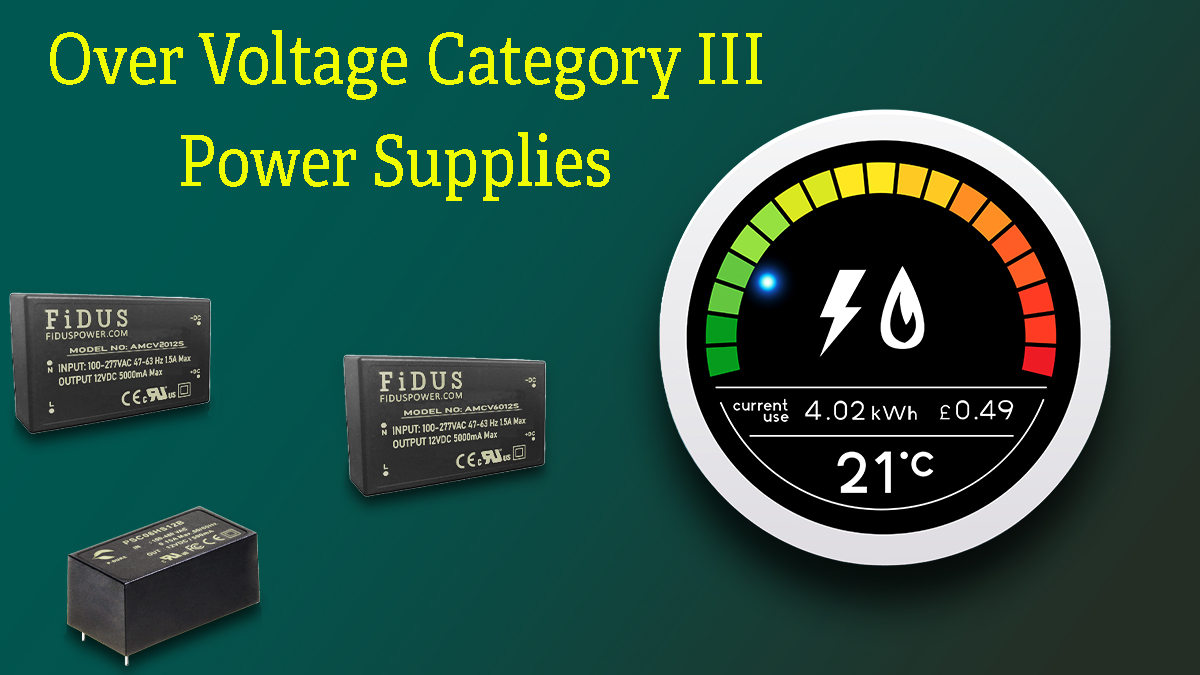Over Voltage Category III encapsulated board mount AC-DC converters for Smart City, Smart metering, EV chargers and Monitoring type applications up to 60W
AC-DC power converters are typically designed for over voltage category II installations connected to the mains ring via mains plug, downstream from the consumer unit (distribution board / fuse board). These new units are designed to be used a level above this, directly connected to the consumer unit on their own circuit breaker.

For more on our PCB mount AC-DC converters click below:
PCB mount AC-DC convertersTypical applications where direct connection to distribution panels include; security systems, access systems, PV systems, EV car chargers, Power monitoring systems, smart metering and booster stations for local communication networks.
OVC I equipment is for connection to circuits where steps have been taken to limit transient or short duration overvoltage already and a stable conditioned supply is provided e.g. equipment containing sensitive electronic circuits with micro controllers where the supply is assumed to be very clean and stable.
OVC II equipment is equipment to be supplied from a fixed installation e.g. appliances and portable tools that plug into a socket on a power ring mains. These devices will have additional protections built in that expect the transients found at this installation level.
OVC III is equipment in fixed installations that are directly wired to consumer units / distribution panels that are exposed to and can handle higher currents and transients than those found in a class II install.
Units such as the PSC06HS, AMCV20 and AMCV60 have been designed with more robust front end (primary) circuitry that can withstand the surges expected of an Over Voltage Category III installation according to 62368-1 and 61558-1. As we follow the power network from the wall socket to the power distribution grid the over voltage class increases with the transients, we expect to find at that level in the power distribution network. At each of these class installations, depending on the mains supply, voltage a corresponding mains transient voltage is expected:
Withstand voltage test for mains transient voltages as per IEC 62368-1 up to 2000M

For three phase installations without a neutral the line to line voltage is to be considered and three phase installations with a neutral present the line to neutral phase should be considered as the mains voltage above.
From the above transient voltage expectation the required clearances associated with these higher withstand voltages are then applied to the design. These distances must increase above 2Km as the dielectric effect of the air decreases as it thins, providing less insulation resistance between two conductors. At 5000m these clearances must be multiplied by 1.48 times! It is important to note that withstand tests are not the same as surge immunity tests (e.g EN61000-4-5) and are applied for longer durations and are to test the safety integrity of the insulation and not the functionality of the equipment from transients.
OVC II equipment requires an additional safety isolation transformer if it is to be connected directly to the consumer unit in an OVC III installation. This of course adds additional expense, weight, and volume to the design, where using a OVC III compliant AC-DC converter negates this, meaning smaller BOMs, less points of failure and simpler board layouts in more modern designs.
The 2”x1” PSC06HS units offer a wide input voltage from 85-530Vac, which can cover from 100, 115, 230, and 277Vac single-phase nominal supply voltage or up to 480Vac three-phase line-to-line supply voltage for a universal power supply. They have integrated filtration and require no additional components for EN55032 emission and EN55024 immunity EMC testing. They operate in harsh environments from -40 to 85°C to altitudes of 5000m and carry safety certification for EN/UL 61010 and EN/IEC/UL 62368-1.
The higher power AMCV20 and 60 also offer and extended temperature range -40 to 85°C, extended AC input range from 85 to 305VAC, 5000m altitude operation and low no load of 0.1W. The 60W facilitates the common rail voltages of 12V 15V and 24V, whereas the 20W extends to 5V, ±12V, ±15V and a double 5V and 12V unit.
If you have an application that requires an OVC III installation and would like to evaluate a sample, please get in touch with your FiDUS Account Manager or call us on 01183 420730.
